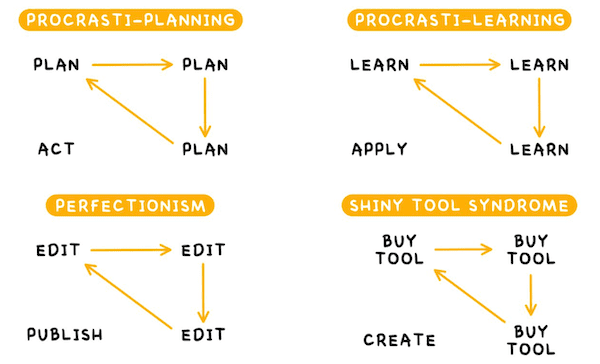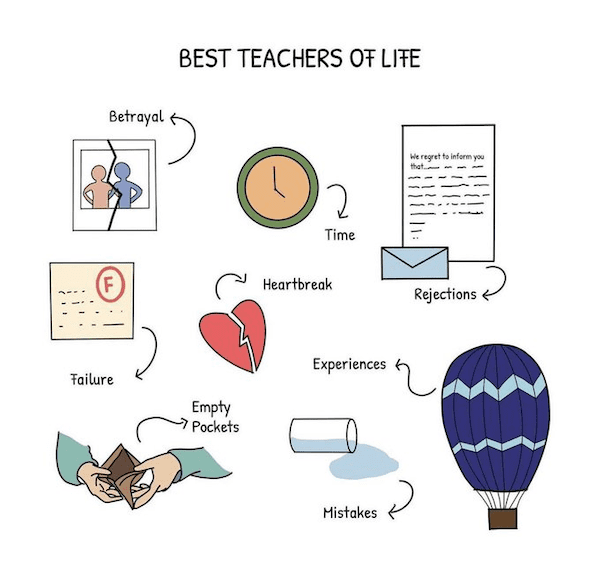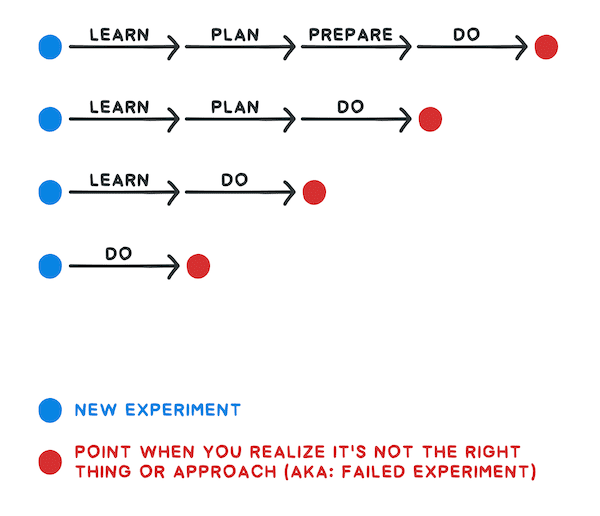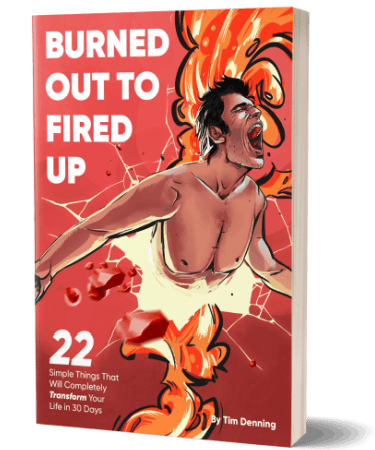The word “learning” gives me diarrhea.
School taught me to hate the word. The high school career counselor said I’d never have a career that involved learning.
She told me I’d be a laborer at best and should just quit school as soon as possible. Hey Ms Douglas, surprise! I ignored the old dingbat.
Traditional learning at school didn’t work because the system is an anti-curiosity machine. Years later I fell in love with learning.
When I stopped choosing what to learn based on what job it could buy me, everything changed. I went back to the traditional education system to study sound engineering. Those years were some of the greatest times of my life. I couldn’t wait to get to class.
Following my curiosity is what helped me learn 210% faster. It’s the first shortcut you must know. Here are some other kickass learning shortcuts.
If the purpose of education is to score well on a test, we’ve lost sight of the real reason for learning.
1. Learning without execution is mindless entertainment
It’s common to bash people on social media who watch Netflix.
The supposed higher class talk down to others by telling them to get off their ass and reads books. Books get held up above the crowd as huge trophies. There’s only one problem…
Many of us are amazing readers. We might even read three books a week. But that’s where it stops.
Reading isn’t learning. Learning is a combination of consumption and execution. Without execution all a book is, is another form of content you read on a Kindle screen.
If you want to learn 210% faster then take action right after you learn something new. The lesson will stick in your brain like superglue then.
2. Learn the 4 basic blockers to learning
It’s easy to get stuck in an insanity loop.
You think you’re learning but it generates zero progress in your life. Without progress learning feels useless and you inevitably give up.
These are the four blockers:

Image credit: @fab_rosato via this tweet (follow him)
I’m a sucker for the last one: shiny tool syndrome. Back in my sound engineering days, I spent ungodly amounts of time always downloading new synthesizers and buying new keyboards.
Instead of making music I got stuck always trying to add new tools. Every new tool I added created some issue with my recording studio that would take months to solve. So I hardly released any music.
The tools you have now are probably more than enough to learn with.
Use the tools you have to produce results and then limit the number of tool upgrades to one every so often.
3. Treat learning like working out
My gym bros gonna love me for this one. The lazy loafers who do zero exercise are gonna hate it. Soz.
The overlap between exercise and learning is incredible. First, exercise helps wake your brain up and is amazing for your learning health.
Beyond that fact, think of learning like this:
Train to upgrade your hardware.
Learn to upgrade your software.
Sweat to debug.
Write to reprogram.
Run to add storage.
Fast to work faster.
Meditate to reset.Your body is an operating system of flesh, feeling and desire.
Upgrade it.
Your body has a lot to do with your ability to learn fast. If you’re in a constant carb hangover or can’t stop yawning, how the hell you gonna learn? You can’t.
4. Enable superhuman pattern recognition
The #1 way I learn is by writing about what I consume.
I store all quotes, knowledge, and lessons in a Roam Research database. Then I write about the ideas I capture.
What this does is help you recognize patterns. When you recognize patterns it increases dopamine levels in the brain (the body’s reward system).
This habit leads you to start seeing patterns you’ve never seen before, because now there’s a way to synthesize all the learning into something that has real-world use and feedback from the crowd online.
Write to learn 105% faster. Hit publish to learn another 115% faster.
5. The untapped teachers in life most people avoid
It’s easy to make your way through life being passive — to avoid pain, rejection, and failure.
But just like the best writers are the ones who’ve actually lived interesting lives, the best learners are too.
Empty pockets, failed romantic relationships, mental illness torture, job rejections, getting fired — these are the experiences that taught me the most.
These hard events teach you to become more resilient. The more you lean into what bad experiences in life can teach you, the faster you can extract the lessons and use them to your advantage.

Image credit: @ArchanaS via this tweet
Stop learning, die young.
Keep learning, stay young.
6. Master the art of learning on your own
Traditional learning happens in groups inside college campuses.
As such, we start out life being addicted to group learning. The thought of learning alone at home can be daunting. It’s not social. This is why we have a mentor epidemic.
Smart people waste too much time trying to find $0 mentors rather than sit alone in a room and learn about a topic. They’re looking for cheat codes to secretly avoid loneliness.
Get used to the loneliness of learning and you’ll learn 210% faster.
7. Reverse engineer your brain to work in your favor
Andrew D. Huberman, Professor of Neurobiology at Stanford Medicine, encourages us to make learning a drug.
He says the feel-good chemistry in our bodies won’t release the natural highs we love unless a struggle happens. It’s why struggle p*rn is so popular, because the struggle makes us feel good.
The #1 way we can get these free drugs, according to Andrew, is by learning a new skill and then applying it.
8. Take advantage of just-in-time learning
Janis Ozolins introduced me to this idea.
The traditional approach is to start with learning. But what if we reversed the order? A smarter approach is to start by taking action. Here’s what it looks like…
Do → Learn → Get Stuck → Do …. Get Stuck → Learn → Do
Now you have a reason to learn. And we know whenever you start with a why, it’s much easier to motivate yourself and get results. Unless we start with action we don’t know what we need to learn in the first place.
The greatest teacher is called “doing” — Kevin Kelly
9. This subtle difference between learning and intelligence is crucial
Learning by itself doesn’t give you any benefits.
What you want from learning is to upgrade your intelligence. Intelligence gained from learning is the result of how fast you change behavior. There’s no point learning if your behavior doesn’t change.
So to track the gap between where you are and how far you’ve come, you need to document your behavior change. This brings it into awareness.
As you notice the behavior change your rate of learning speeds up.
10. Shorten your failure cycle
This last mental model also comes from Janis and looks like this:

Image credit: @OzolinsJanis via this tweet
The traditional learning model is to learn, prepare plan, do. This is what I did to study sound engineering.
I spent about 5 years just learning, planning, and preparing.
At the end of the process started the “do” part. Quickly I figured out this wasn’t the path in life for me. The problem is I wasted years to determine it was a failed experiment.
When you remove all the steps from the cycle and simply execute, learning experiments help you see results faster. That can save you years. This is how I learned to write online by accident. I didn’t learn, plan, or prepare.
Like a dumb dog, I just went straight to “do.” I had no clue what I was doing and told myself “you’ll figure it out as ya go mate.” And I did.
The greatest shortcut to learning anything faster is to have a massive bias toward execution. Because experiments require the act of doing to produce data you can analyze.
Just do.


